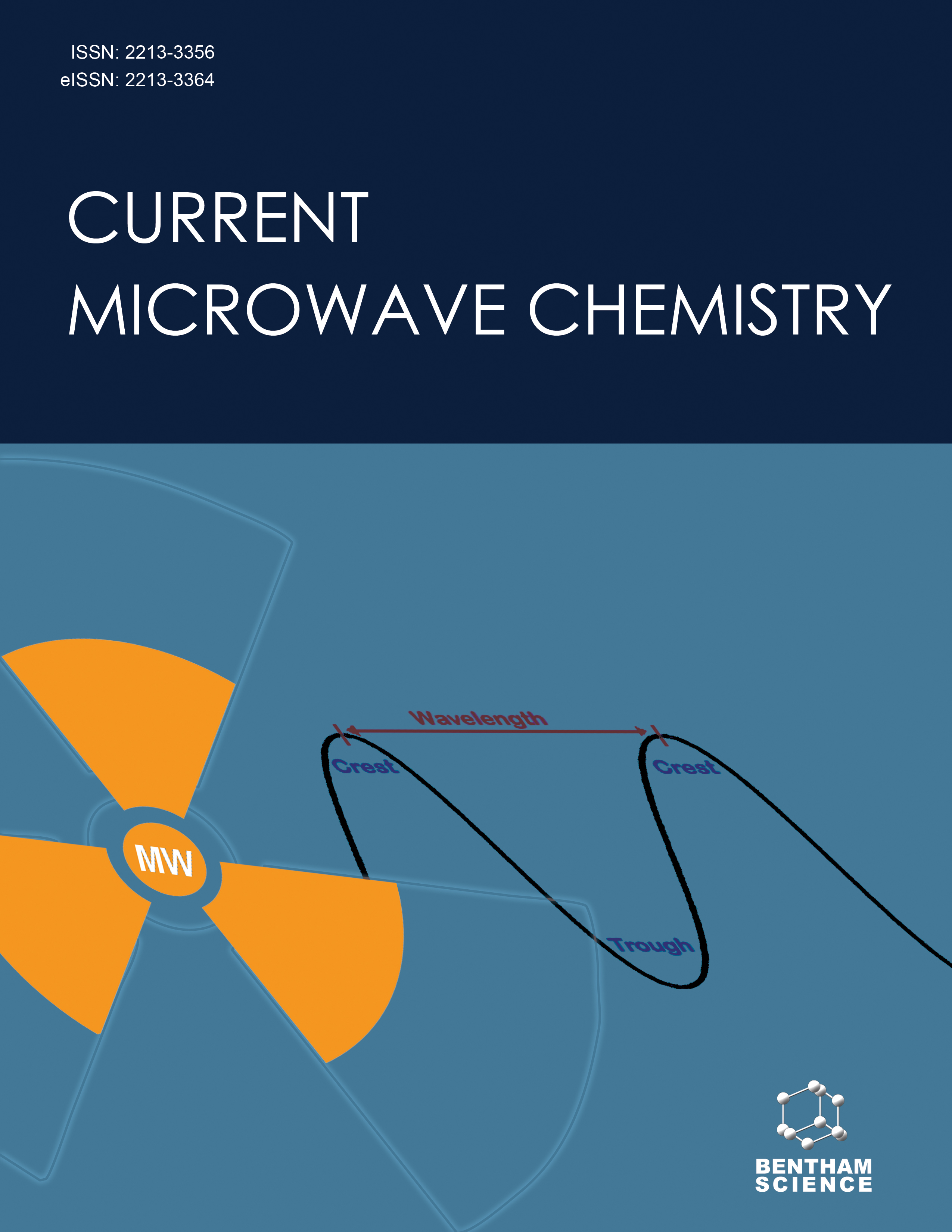- Home
- A-Z Publications
- Current Microwave Chemistry
- Previous Issues
- Volume 4, Issue 3, 2017
Current Microwave Chemistry - Volume 4, Issue 3, 2017
Volume 4, Issue 3, 2017
-
-
Microwave Radiation-Induced Increases in Catalytic Performance: The Effect of Bedshape During Irradiation
More LessAuthors: Linda Z. Linganiso and Mike S. ScurrellBackground: Improved catalytic effects have been seen using iron-based catalysts after exposure to microwave radiation. It was suspected that these effects would be much more pronounced when thin disks of loose powder are used for the microwave treatment rather than cone shaped sample with a mean thickness of about 10 times that of the disks. Methods: Catalyst samples have been subjected to microwave radiati Read More
-
-
-
Biocatalytic Production of Chiral Benzotriazoles Employing Conventional Heating and Microwave Radiation
More LessBackground: This paper describes the synthesis of chiral 1,2,3-benzotriazoles by the enzymatic kinetic resolution of β-azidoalcohols using lipase from Candida antarctica B followed by a [3+2] cycloaddition reaction involving benzyne formation from 2-(trimethylsilyl)phenyl triflate and CsF under conventional heating and microwave radiation. (±)-1,2,3-Benzotriazoles were tested in vitro to evaluate their cytotoxic effects on Read More
-
-
-
Microwave Assisted Extraction and in vitro Evaluation of urease Inhibition Potential of Stem Bark of Terminalia arjuna
More LessAuthors: Sarita Khatkar, Arun Nanda and S.H. AnsariBackground: The Terminalia chebula has been reported for the urease inhibition activity while the cardioactive Terminalia arjuna has not been reported for anti-urease activity. The Terminalia arjuna has been reported to lower the nickel toxicity in rice and hence, an attempt has been made by the authors to find the inhibition potential for nickel containing urease enzyme by the bark extract of Terminalia arjuna. Objective: Th Read More
-
-
-
Wheat Straw Bio-refining. Part I: Optimization of the Microwave Radiation Process with Sulphuric Acid Pre-treatment
More LessAuthors: Huseyin Demirhan, Ahmad Fauzi, Vassiliki K Skoulou, Stephanie H. Haywood and Sharif H. ZeinBackground: This study investigates the microwave-assisted acid extraction of lignin from wheat straw. Methods: Two experimental design methods, the Central Composite Design (CCD) and the Response Surface Method (RSM) methods were used to select conditions and optimise the process. The parameters studied were: the stirring rate, H2SO4 concentration, microwave radiation power and residence time. Results: The opti Read More
-
-
-
Cycloaddition Reactions Assisted by Microwave Irradiation: Protic Ionic liquids vs Solvent-free Conditions
More LessAuthors: Pedro M. E. Mancini, Maria N. Kneeteman, Mauro Cainelli and Carla M. OrmacheaBackground: The behavior of N-tosylnitroindoles acting as electrophilic dienophiles in polar Diels-Alder reactions joint to different dienes was analyzed. Reactions were developed under microwave irradiation using toluene or protic ionic liquids as solvents under solvent-free conditions. Good yields in short reaction times were observed. Solvent-free conditions and protic ionic liquids as solvents offered similar results. Ho Read More
-
-
-
Fast and Efficient Synthesis of Maculalactone Derivatives via the Microwave Technique
More LessAuthors: Daniel Previdi, Mayla Eduarda Rosa and Paulo Marcos DonateBackground: The γ-butyrolactone ring is present in many natural products that exhibit a broad spectrum of biological effects. Tribenzylbutyrolactones, known as maculalactones, are compounds isolated from cyanobacterial species that display diverse biological properties. Given the difficulty in isolating large amounts of maculalactones from natural sources, interest in synthesizing structural analogs of thes Read More
-
-
-
Microwave-assisted Iodine-catalyzed Rapid Synthesis of 6H-indolo[2,3-b] quinolines: Formal Synthesis of Cryptotackieine
More LessBackground: Indoloquinoline alkaloids are of great importance due to their unique structure and various biological activities. Several methods have been developed to synthesize indoloquinolines and among those, one-pot methods are of particular importance due to its simplified reaction procedure. Methods: We investigated the one-pot reaction of indole-3-carboxyaldehyde and aniline in presence of catalytic amount of I2 Read More
-
-
-
Graph Theoretical Analysis, Insilico Modeling, Design and Synthesis of Biologically Active Pyrimidines and Quinazolines as Antimicrobial and Antitubercular Agent
More LessBackround: Twenty four 4-(4-substituted phenyl)-6-(furan-2-yl)-3,4-dihydro pyrimidin-2(1H)-one,4-(4-substituted phenyl)-6-(furan-2-yl)-3,4-dihydro pyrimidin-2(1H)-thione and 4-substituted phenyl-3,4,5,6,7,8-hexa hydro quinazolin-2(1H)-one, 4-substituted phenyl-3,4,5,6,7,8-hexa hydro quinazoline-2(1H)-thione derivatives were constitute attractive targets for the development of active antimicrobial as well as antimycob Read More
-
-
-
Ligand Free Microwave Assisted Copper-Catalyzed Convenient Synthesis of Substituted Tertiary Amines from Nitroarenes
More LessAuthors: Kshipra S. Karnik, Aniket P. Sarkate, Sushilkumar S. Bahekar and Pravin S. WakteBackground: A ligand free, microwave assisted, copper catalyzed synthetic procedure for substituted tertiary amines has been developed by using nitroarenes and secondary amines. Methods: In the synthetic method, the targeted substituted tertiary amines were synthesized with the help of the microwave by reacting nitroarenes and substituted secondary amines in the presence of copper, potassium carbonate and methano Read More
-
-
-
Optimization of Microwave-Assisted Dilute Acid Pretreatment for Enhanced Structural Breakdown and Enzymatic Saccharification of Lignocellulo-Starch Biomass
More LessAuthors: Madhanamohanan G .Mithra, Gourikutty Padmaja and Janardhanan SreekumarBackground: Rapid depletion in petroleum resources coupled with environmental pollution from the burning of coal and oil has led to the search for alternative energy sources. Lignocellulostarch biomasses (LCSBs) comprising peels of root crops and vegetables causes environmental hazards due to their non-judicious disposal. They are highly recalcitrant to breakdown necessitating effective pretreatment to exploit their use as bio Read More
-
Most Read This Month
Article
content/journals/cmic
Journal
10
5
false
en


